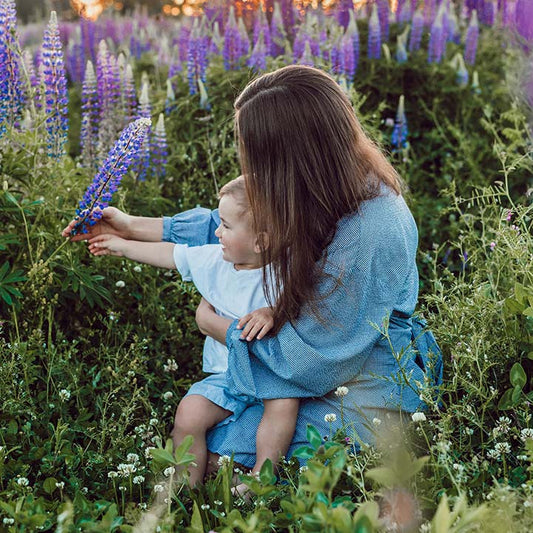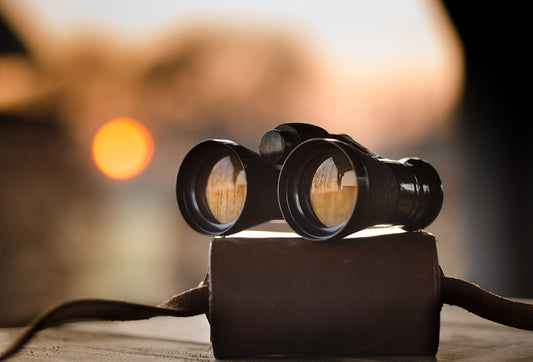Maybe you’re tired of viewing nature through a screen, and want to attract the real deal to your own space. Maybe you’re sick of uniformly boring, monoculture, high maintenance lawns. Maybe you’re a bird lover, a bee saver, or just want to put a luscious green dent in your carbon footprint. We’ve got you covered for all of the above!
Read on…
“There’s water gushing out of the driveway. Is that normal?” the text reads on my phone.
The precious well water line to our house had finally cracked after battling a constant 60 pounds per square inch and years of steady vehicular traffic. Apparently, it couldn’t bear the pressure.
I sent a text back, “Nope! Definitely not normal!”
“When you’re out of water,
it’s kind of a big deal”
When you’re out of water, it’s kind of a big deal. Something changes mentally when the bear necessities are under attack. And that forces a point…
What about wildlife?

“When we try to pick out anything by itself, we find it hitched to everything else in the universe.”
~John Muir
It might seem obvious, but every living thing requires resources. Be it water, minerals, oxygen, or something else.
Perhaps less obvious, every living thing is connected, and often in complex ways that make up delicate ecosystems.
Did you know? The humble bee is responsible for 80% of the world’s pollination!
“Every living thing is connected, and often times in very complex ways that make up delicate ecosystems.”
And that leads me again to a point.
What about wildlife conservation?
Truly, I’m blessed to call America my home. And there are at least a few things I take for granted. The constant barrage of technology & urbanization, the convenience of the grocery store, and overwhelming pressure to ‘keep up with the Smiths’ has perhaps underplayed something criminally important…
What about wildlife?
Let’s pause for a second.
Pop quiz…
What do Wildlife, Raw Resources, and We humans all have in common?
A Yard!
“If we save our wild places, we ultimately save ourselves.”
~ Steve Irwin
Whether you’ve got a small balcony, a patch of weeds, or your own private forest, opportunity abounds to make a better, more wildlife-friendly yard.
“Remember this … Biodiversity”
Remember this … “Biodiversity”. If I remember anything from my college Sustainability class, it’s that. Biodiversity makes stronger ecosystems, healthier wildlife, and happier people.
If that sounds like you…
Here are 7 Dirt Simple Tips for a Wildlife-Friendly Yard that’ll make you look like an eco-genius.
1. Consider electric lawn equipment

Tired of exhaust fumes, noise, spark plugs, and oil changes? Enter electric yard equipment!
These babies were born for the 21st century and arguably have a much smaller carbon footprint than their gas-powered counterparts. We bought a cordless Ego mower and trimmer and are thoroughly in Love!
If you’ve got a small yard, consider a simple corded version. They’re much cheaper, and in case you have any doubts, electric motors can pack a wallop!
Want a workout? Try a human powered push mower, especially for small lawns. Sometimes old is gold! Shucks, it beats a treadmill!
2. Low Maintenance Lawns & Edible Landscaping

Traditional lawns stink. There, I’ve said it. I’ve realized, the less mowing I’m stuck with, the happier I am, and if I don’t have to water or fertilize as much, even better.
That’s what got me digging for alternatives…
- Clover - White Dutch, Red, Yellow – the list goes on. Clover is an excellent cover crop, a natural nitrogen fixer and therefore lawn fertilizer. It also helps shade exposed soil and reduces watering needs.
- Hairy Vetch - Also known as Fodder Vetch, is another member of the Legume family that makes a great cover crop. Though, its a bit more spindly than clover.
- No Mow or Drought Tolerant Native Grass Mixes - The variety will depend on the amount of foot traffic in the area, and your tastes. There are thousands of grass species, which means options! Try to source a mix locally, you’ll generally have better luck if you do.
- Edible Landscape! - If you’ve got a little time, think about replacing your lawn with a walk-through garden, or mixing in some edible plant varieties! Heirloom fruits like Jelly Palms that you can't find in the store? Yes, Please!
3.Biodiversity

Shhh… It’s magic. Seriously, if you remember one thing, make it Biodiversity! This one holds the keys to your paradise and a healthier world to boot. It’s the secret ingredient behind many successful organic farms, beautiful yards, and home gardens.
Biodiversity means this - Greater numbers of plant and animal species lead to healthier plants and healthier animals.
Plant some flowers, Plant some Trees, Plant a blooming orchard, and you’re sure to have birds, butterflies, and bees.
4. Bird Houses & Bee Hives

Have rodent problems? Owls make excellent predators and will happily make a meal out of your moles, voles, mice, gophers and other pests. Consider mounting a large Owl house in a shaded location to attract a friend or two.
Got bugs? Birdhouses and Bird Baths are one small step into birder haven! Birds are bug scarfing marvels, eating a large variety of insects, including nasty mosquitoes and beetles. They do more than we can imagine keeping systems in balance. Prepare to be dazzled by a variety of colors and songs!
Love Honey? Need pollination? Want to help the honey bee population? Or maybe you’d like a new hobby. Beekeeping might be for you. Feel good doing your part to keep the world’s breadbasket thriving. Just watching bees can be incredibly relaxing and satisfying for some. According to some, a single hive only requires about a half-hour of care each week.
5. Cut the Chemicals

Truth can be sobering. But let’s be real. There are hidden impacts with everything we buy and consume. Not just lawn care chemicals, but groceries, clothing, even pharmaceuticals too! Think about it…
Here’s a shortlist of common chemical categories and alternatives.
- Fertilizer– If you’ve got chickens, rabbits, or critters, you may have all the fertilizer you need. If not, consider Biodiversity or Permaculture techniques as healthy ways to fertilize. For grass, consider over-seeding. The point is, anything natural will surpass highly-commercialized weed-n-feed type formulas and herbicides (glyphosate, atrazine, et al) which contribute to cancer, damage water sources, harm aquatic animals, destroy soil microbial life, and more!
- Herbicides– Try a 20% Vinegar solution instead! We use it in our driveway to kill new weed sprouts.
- Pesticides – Remember the acronym E.E.P (the sound you make when there are bugs in your house - "eep!"); Environment, Entry, and Predators. Bugs always travel with a motive. Usually, that’s to eat, drink, and reproduce. If you’ve got holes in your house, plug them up as best you can. If you’ve got food lying around attracting roaches, ants, or other pests, clean and polish. If you’ve got a slug and snail problem in your garden, eliminate rocks and other cool, moist, shady places. Slugs are criminal slime! But they can't beat the heat! The old copper tape perimeter trick sometimes works for Slugs as well, or borrow some ducks! Ducks consider slugs and snails a delicacy (Maybe they’re French?). If all else fails, try some Natural or Organic forms of pesticides (e.g. Sluggo) that don’t have any lasting harm on the environment. Anything to avoid using extremely toxic and environmentally damaging synthetic pesticides like Chlorpyrifos!
6. Leave the Leafs

Leaves are great. That is when you don’t have to rake many of them. Contrary to some advice, you may consider leaving the leaves. If they're not smothering anything essential, leaves are a very natural environment around trees.
A thin layer of decomposing leaves does wonders for earthworms and soil life.
Alternatively, you can always mow the leaves in place to help them decompose faster.
7. Compost

I know what you're thinking - Gross! And then maybe - Ew, worms!
I get it, they aren't very appetizing. But, think twice before throwing those food scraps in the garbage disposal (we think garbage disposals are a terrible invention b.t.w.)! There’s a far better use for banana peels, avocado skins, eggshells, and other bits!
Intimidated? Have no fear! You’ll have rich nutrient-dense fertilizer for yard and garden! Something you’d otherwise pay a premium for.
Once you’ve got a spot carved out, compost piles only need a few basic things to get started:
- Moisture
- Oxygen. A rotating bin or perforated/screen retaining walls can be a great help here. Turning the pile with a shovel every week or two works pretty well too. You can also try a few pieces of vertical PVC pipe with holes drilled in them.
- Browns and Greens. A good even mix of carbon and nitrogen, or browns and greens. Brown leaves, wood mulch, straw, wood ash, cardboard, and other carbon-rich materials make up your browns. Chicken manure, fruit and produce scraps, fresh grass or weeds, and other nitrogen-rich materials are your greens.
You’ll have a mound of earthworms in no time flat!
Note it’s a good idea to have several piles going at once. Alternate piles each year while one fully decomposes; especially if you plan on using this in your food garden.
For more Homesteading ideas, pay a visit to our friends at Outdoor Happens.



